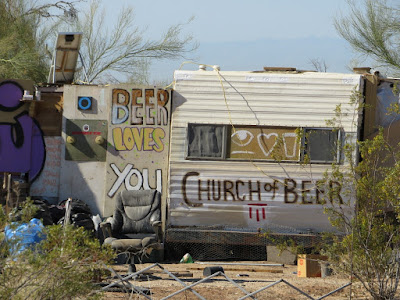Ghost Mountain with Friends...
Our list of things to do in Anza Borrego is pretty extensive. For our last day in the desert, our friends, Scott and Lynne met us at our campsite. Our goal was conquering Ghost Mountain.
"Amidst the dust and the silence, someone might, just conceivably, be inspired to camp for a few days. But to choose this place for a home, to try to survive here month after month, year after year, building a mud-walled shelter, conceiving children, raising them up from infancy, to do all that in the absence of not just roads or telephones or electricity but even of water (other than what could be hauled up the trail or caught as rainfall) — this, for most people, would be unthinkable. Yet Marshal South did this, and something more."For 17 years, from 1930 to 1947, poet, artist, and author Marshal South (born Roy Bennett Richards) and his family lived on Ghost Mountain—a remote, waterless mountaintop that is today within California’s Anza-Borrego Desert State Park. Over a period of nine of those years, South chronicled his family’s controversial primitive lifestyle through popular monthly articles written for Desert Magazine. They were the precursors to modern day hippies.
But why? In the Saturday Evening Post dated March 11, 1939, he explains the forces that drove him, at age 45, into San Diego’s barren wilds “We were tired ... out of step," he wrote. “We were temperamental misfits and innate barbarians and we were not equal to the job of coping with modem, high-power civilization.”
This rugged family lived off the land, as best they could. Chia seeds, ground here, were one of their main staples.
Being here we continued to ask ourselves, "Why?"
The desert patriarch’s philosophy was an antiwar, pro-ecological brew seasoned with its own oddball flavors. He preached the moral superiority of bare feet, for example, and informed his readers that Nature intended for hair to be uncut. Clothing he saw as a "body-choking impediment,” and electric lighting assaulted man’s “sensitive eye nerves” and ruined his vision. And he found a woman to go along with his plan (he met Tanya at Oceanside's Rosicrucian Fellowship). Wow.
The home faced magnetic east to catch the rays of the morning sun. In its final form in the l940s, the interior of the house measured 15 feet by almost 40 feet. It looked larger because the adobe walls were from 1-2 feet thick. There were basically two rooms. The northern room was the front room with the entrance and large windows. The west side of this room was screened and mouse-proof and was used to store food. The central part of the south room had a large adobe stove, a fireplace, a dining table, and two food coolers. A bed area was next to the southern wall.
The grand experiment came to an end with Tanya seeking a divorce. In the settlement she was awarded the homestead and Marshal was forced to leave. A year later, he was dead (I believe of a broken heart).
Near the end of his life, Marshal admitted, "The desert has a way of sapping dreams. And more often than not, heroic plans wilt bit by bit." So sad.
On a much happier note, Scott and Lynne fed us back at camp. It was an evening of delicious food and great company.
And birthday wishes coming true!
Tomorrow, after traversing 848 miles of incredible, and varied terrain, we head home. What an exceptional birthday road trip.
“Map out your future – but do it in pencil.
The road ahead is as long as you make it.
Make it worth the trip.”
– Jon Bon Jovi































































Recent Comments